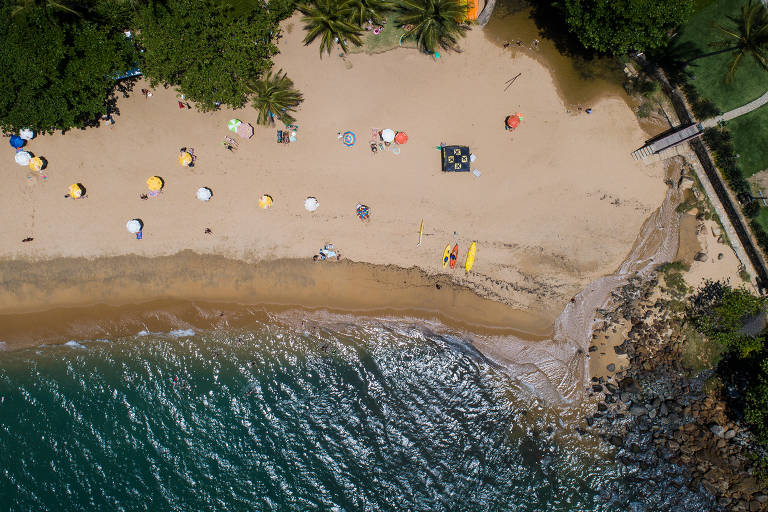November 29, 2018, was a historic day for the town of Ilhabela: the city deposited R$ 55 million (US$ 15 million) in its sovereign wealth fund. The money was originated from oil royalties.
Only two months later, another side of Ilhabela emerged: last Wednesday (29th) all 19 beaches located on the island's canal had a red flag, indicating that their water was so polluted with fecal coliforms it was rendered unsafe for swimming.
The foul smell and beige-colored stains on the seawater weren't the only problems affecting the island. During the last New Year's holiday, chaos ensued: there were water shortages, and the traffic was deadlocked. Cars couldn't get out of the ferry that transports vehicles and people from the island to mainland and back, and water trucks couldn't reach neighborhoods depleted of drinking water.
Ilhabela's city hall says that 120,000 entered the island between December 26 and January 2nd, three times the town's population.
On the first week of January, state water quality inspectors placed red flags on 18 of the 19 canal beaches.
The question, repeated as a chorus all around the island, is obvious: how a prosperous town like Ilhabela got to this?
Ilhabela is Brazil's most affluent town in terms of town budget per capita; with a population of 34,333, according to the 2018 Census, its budget was R$ 941,4 million (US$ 256 million), which results in R$ 27,422 (US$ 7,473) per resident. It's so much money that last year the city left R$ 400 million (US$ 109 million) from the budget unspent.
Such rich coffers in such a small town are the direct result of the pre-salt oil exploration off Ilhabela's shore. From Petrobras alone, the city received R$ 751.7 million (US$ 204 million) in royalties, equivalent to 80% of its total budget.
Even when compared to other Brazilian municipalities that also receive pre-salt royalties like Niterói and Maricá, in the state of Rio, Ilhabela is richer because it is less populated. Maricá has R$ 8,873 (US$ 2,418) per resident and Niterói, R$ 4,472 (US$ 1,218) -- all data from 2018. For comparison's sake, São Paulo had R$ 4,448 (US$ 1,212) per resident last year.
"The island got to this state due to incompetence and corruption," says Georges Henry Grego, president of the council at Instituto Ilhabela Sustentável, a nonprofit created in 2007 to advocate for better sanitation at Ilhabela. "With so much money, this town should be a worldwide example in basic sanitation."
There's no consensus on what is causing the beach pollution. While the town administration and state inspectors blame the rainfall that drives sewage to the sea and illegal occupation, Gilda Nunes, president of the towns Environmental Council, says that lack of treatment of raw sewage that reaches the canal between the island and the coastal city of São Sebastião is the culprit. A large number of tourists also plays a role, according to her.
Mayor Márcio Tenório (MDB) says this is an isolated occurrence. "The red flag in 18 beaches was caused by a heavy rainstorm that brought too much rainwater, and this rainwater sent all the sewage to the sea," he said.
Translated by NATASHA MADOV
